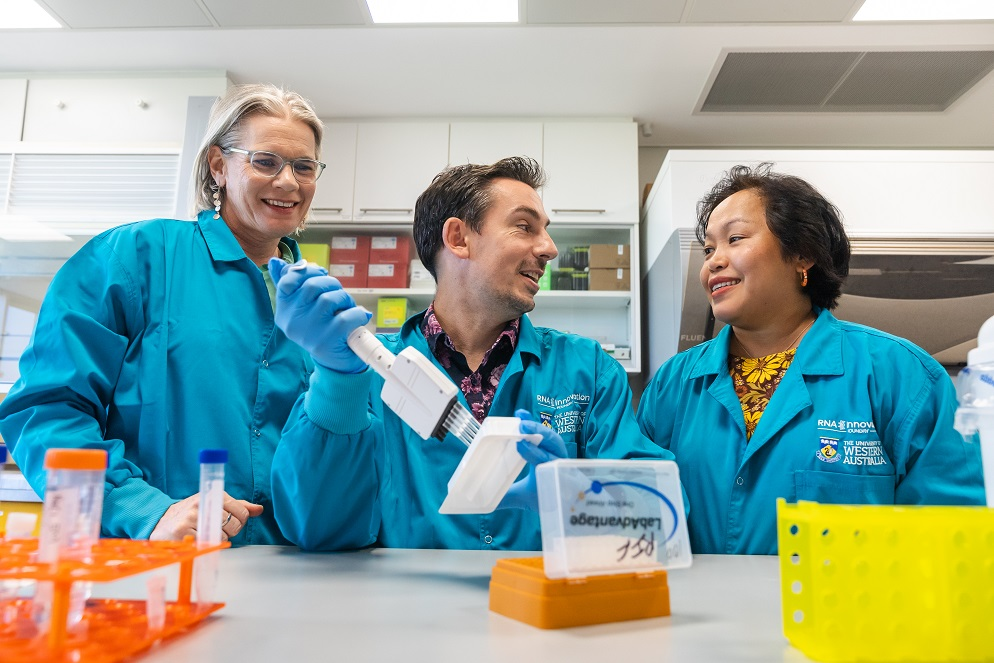A new research centre is advancing cancer treatments by developing and testing RNA therapies that can be tailored to individual patients and tumours.
Professor Archa Fox, from UWA’s School of Human Sciences, is leading the research at the Australian Centre for RNA Therapeutics in Cancer based at UWA.
The new category of medicine is based on messenger ribonucleic acids (mRNA), a natural molecule our bodies make that is an intermediate between DNA and proteins.
When the global pandemic hit, a COVID-19 vaccine using mRNA became the first approved therapy using the power of this technology.
“It opened the floodgates to harnessing this technology for lots of different diseases,” Professor Fox says.
“The beauty of mRNA is that instead of making a protein in a factory and using that as a medicine, you can have an individual’s own cells make the proteins they need by giving them the precursor, which is the mRNA.”
Professor Fox’s fascination with all forms of RNA began when she was a PhD student and wanted to understand how a single human fertilised egg eventually becomes a person — how each of our cells has the same DNA, yet one cell can look so different to another, and different cells have different roles.

“The key is understanding that RNA, that is made from DNA, drives cellular differences,” she explains.
“I like to say the RNA is what brings the genome to life and that’s what I’ve spent my whole career studying.
I was also intrigued by how a normal human cell mutates and becomes a tumour cell.”
Professor Fox’s interest in how cell works and the role of RNA in that process made a move into researching it as a therapy a natural progression.
The instructions for how to make a useful protein are in our DNA and are very similar in everyone,” Professor Fox explains.
For some applications, like the COVID-19 vaccines, we could develop and deliver the same mRNA sequence, coding for the SARS-COV2 spike protein, to each person.”
RNA technology can be a little more complicated as researchers move into the possibility of designing tailor-made treatments specific to an individual.
This is being pursued already with certain types of cancer treatments where the patients can get a unique, only-person in the world treatment based on their tumour,” she says.
Individualised vaccines for cancer are at phase two trial stage for some companies.
Our centre is working with renowned UWA researchers from the National Centre for Asbestos Related Diseases to help them bring their prior lung cancer vaccine program to the clinic with mRNA.”
Professor Fox says it takes a lot of people working in teams to make breakthroughs, including the people who have lived experience of disease.
My job is to make sure we build a community of researchers who share the passion and vision to make real progress – and do anything I can to help them succeed,” she says.
Our community also has those with lived experience of having cancer and caring for people with cancer. Their voice is pivotal to guide us.”
Currently at the centre, researchers are working on five pilot projects focused on treating aggressive and hard-to-treat cancers using RNA therapies.
“Each pilot project takes a team approach and tackles a different cancer to develop treatments using a specific platform capability.
We’re specialising in the really problematic, aggressive hard-to-treat cancers and trying to come up with new ways to use mRNA, working from the concept through to preclinical work and hopefully to clinical trial.”
As well as the lung cancer project the team is developing four other RNA treatments including: for sarcoma, led by Dr Ben Wylie, from The Kids Research Institute Australia; pancreatic cancer, led by Associate Professor Juliana Hamzah from Harry Perkins Institute of Medical Research; and two different type of breast cancer — triple negative cancer led by Dr Ben Dwyer, from Curtin University, and estrogen-receptor positive cancer led by Associate Professor Pieter Eichorn, also from Curtin University.
The reason we’ve chosen those cancers is because we are building on years of research that experts in those cancer types have already been doing at many different institutions in WA,” Professor Fox says.
“Our centre connects the people with expertise in cancer and understanding of target molecules with people, like myself, who understand RNA and how to produce it and test it.”
Professor Archa Fox, UWA’s School of Human Sciences
To produce the mRNA therapies, a platform approach is taken where the only thing that changes is the sample taken during a biopsy.
“A team of lung cancer specialists (Dr Alec Redwood, Professor Jenette Creaney and Professor Bruce Robinson) spent years identifying what are called neo-epitopes — the tiny little changes that happen in one tumour compared to another,” Professor Fox explains.

“It’s a computational project to take all the sequences from a person’s tumour and figure out the changes that are occurring — once you have the ability to do that for one tumour, you can do it for another and another.
“You don’t have to reinvent the wheel every time because it’s just the information going into the beginning of the pipeline that is slightly different.”
This year, the centre is in a position to start making mRNA to test as well as starting innovative new research to improve the mRNA, so it lasts longer once it goes into cells and the beneficial therapeutic effect is more sustained.
“The beauty of mRNA is that, like DNA — it’s just a simple sequence of four nucleotides,” Professor Fox says.
“For every strand of mRNA the manufacturing process is the same, the only thing that changes is the mRNA sequence.”
At the centre’s RNA Innovation Foundry, an mRNA production facility, staff and students are learning industry-readiness skills while creating a high-quality assured product.
“This is going to be a huge asset to UWA because it’s going to teach our students about what the biotechnology and pharmaceutical industry needs,” Professor Fox says.
“mRNA is now known as the fourth pillar of the pharmaceutical industry and if we can be both innovative, as well as producing quality mRNA, it’s going to be a great training experience.”
Professor Fox is well-known for her 2002 discovery of small structures within the nucleus of our cells called paraspeckles.
Paraspeckles are formed through a different type of RNA, a “long noncoding RNA”, and are needed by cells to help them respond to different stresses.
Professor Fox believes that one day her discovery could form the basis of new treatments for disease.
“We developed a slightly different approach to mRNA, using an RNA technology called antisense oligonucleotides, to regulate paraspeckles and change cell health,” she says.
“We are collaborating with other experts to test this treatment for different diseases.”
In the meantime, a collective effort from scientists around the world working on RNA therapies and biotech and pharmaceutical companies, with clinicians for guidance, is needed before the full potential of RNA therapeutics can be realised.
“We need to do the research to see what works and what doesn’t and share what we find, to push the field forward,” she says.
“This centre is a great opportunity to help research progress and get treatments to the clinic faster.
“That’s partly because manufacturing mRNA is relatively quick compared to other therapies, so it has the potential to shorten the time it takes to go from concept to clinical trials.”
The Cancer Research Trust provided funding over five years to establish the Australian Centre for RNA Therapeutics in Cancer. Other funding partners include Therapeutic Innovations Australia, UWA, WA State Government’s Future Health Research and Innovation Fund, Harry Perkins Institute of Medical Research, The Kids Research Institute Australia, Cancer Council WA, The Ian Potter Foundation, Curtin University and global life sciences company Cytiva.
Read the original article here at UWA News.


